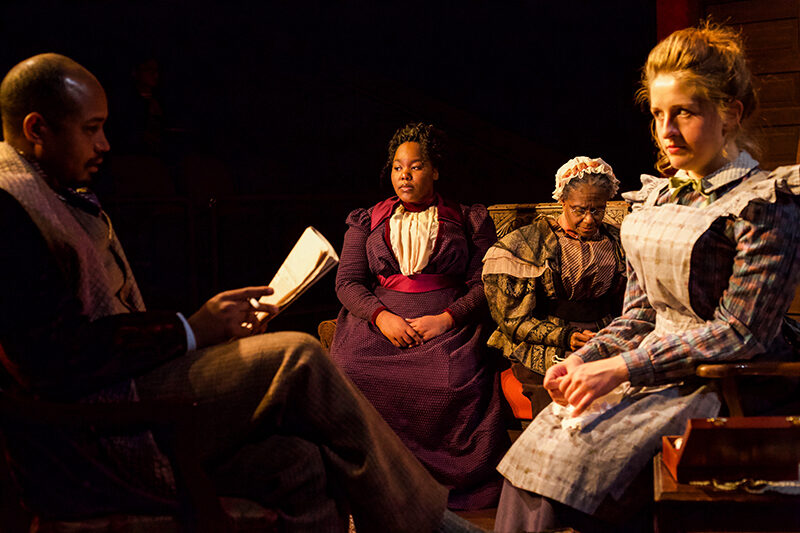Githa Sowerby’s Rutherford and Son Defies Its 20th Century Setting
Review of Rutherford and Son at UW Drama
Written by TeenTix Press Corps Newsroom Writer Eileen MacDonald and edited by Teen Editorial Staff Member Anya Shukla!

In 1912, Rutherford and Son, written by anonymous playwright K.G. Sowerby, was heralded as a masterpiece and placed on a list of the top 100 plays of the 20th century. When it was later revealed that the author was, in fact, the female writer Githa Sowerby, critics were shocked—yet the meaning of the piece became all the more profound.
Performed for the third time in the United States, the play is the thesis production of third year MFA (Masters of Fine Arts) directing student, Cody Holliday Haefner, and examines the life of a family overcoming obstacles in a sexist, classist, and racist society. John Rutherford (guest actor Brace Evans) is the patriarch of an upper class family on the brink of coming undone. As he desperately tries to save the family glassmaking business, he fails to recognize that his family has been torn apart by his actions and expectations.

Still from Rutherford and Son at UW Drama, photo by Kyler Martin
Janet, Rutherford’s only daughter, (Allyson Lee Brown, third year Professional Actor Training Program [PATP] student), and Mary (Alyssa Franks, second year PATP), wife of Rutherford’s son John, are two women in a house reeking of patriarchal values. Yet, they are perhaps the most dynamic characters of the show. The performances of Brown and Franks, while very different, are powerful representations of female empowerment and the ways in which women can overcome the silence imposed upon them. Brown’s fiery passion and Franks’ rational calm instill both a sense of hope and melancholy in the audience: with such women in the world, equality will be achieved... however, a century after the play was written, we have failed to achieve it.
The first act of the play consists of a lengthy and fairly heated exchange between Rutherford and John (AJ Friday, third year PATP) while the women sit by the fire in silence. In this scene, the men are portrayed with childish energy and a need for financial dominance. John, in particular, appears self-centered, with little room in his vision for economic gain for his wife or newborn child. Friday’s depiction of the character captures the pride and impulsivity of a man who has given up on his father’s approval and chosen to take charge of his own life. Juxtaposed with Evan’s portrayal of the stubborn, old-fashioned father, the scene makes for a clash of toxic masculinity—a fight that is as easily witnessed today as it was in the early 1900s. While a bit hard to follow for those who do not understand the nuance of business, this act establishes the tense nature of the relationships within the house, while the staging—the family sitting together around the fire—creates the effect of a feigned closeness.
The character arcs and storyline mirror Sowerby’s childhood and feminist experience in the early 20th century, while resonating with similar incidents in the present day. Specifically, Brown and Franks’ captivating performances have a quiet power that grows louder as the play goes on. In the later acts, the male characters maintain a lack of conviction in their words and actions, while the women, at first silent and palpably uncomfortable in the presence of the men around them, find the strength to take charge of their lives without relying on their male counterparts. Janet, as an independent woman, learns to live for herself, and Mary, as a mother fiercely protective of her child, does everything she can to to ensure a good life for him. The show celebrates two equally inspiring types of women that surpass the societal expectations of their time.

Still from Rutherford and Son at UW Drama, photo by Kyler Martin
In addition, Haefner’s decision to cast African American actors as the Rutherford family adds an essential layer of race to the play’s commentary on class and sexism. The Rutherford family has done everything within their power to build up their status and their business. But, when it comes down to it, they are still not accepted by the upper class families around them. Janet, as a woman of color, is more aware of this separation than any other character. And, unlike Rutherford, she is unwilling to ignore it, telling her father: “Do you think they don't know the difference? It's in our blood, in our hands and faces, and when we marry, we marry common.” Regardless of the family’s successes, the rest of the world does not hold the Rutherfords in high esteem. Thus, John Rutherford responds by isolating his children from the outside world, a tactic detrimental in its own right. Haefner’s choice works to modernize the piece and the difficulties people of color face in all aspects of business and society. Without it, the story would no longer hold the same resonance.
Githa Sowerby’s feminist approach to family business in Rutherford and Son turns a lesson in finances into an engaging and layered commentary on gender dynamics in the early 1900s. Profound dialogue, complex power dynamics, suspenseful tension, and engaging performances combine with Haefner’s modern vision, creating a show rich with lessons and worth the three-hour runtime.
The Teen Editorial Staff is made up of 5 teens who curate the review portion of the TeenTix blog and manage the TeenTix Newsroom. More information about the Teen Editorial Staff can be found HERE.
The TeenTix Press Corps promotes critical thinking, communication, and information literacy through criticism and journalism practice for teens. For more information about the Press Corps program see HERE.


